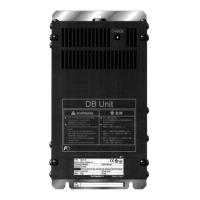11.8 Braking Resistors (DBRs) and Braking Units
11-20
11.8.2 Braking resistors (DBRs)
A braking resistor converts regenerative energy generated from the deceleration of the motor to heat. Use of a
braking resistor results in improved deceleration performance of the inverter.
[ 1 ] Standard model
The standard model of a braking resistor integrates a facility that detects the temperature on the heat sink of the
resistor and outputs a digital ON/OFF signal if the temperature exceeds the specified level (as an overheating
warning signal). To ensure that the signal is recognized at one of the digital input terminals of the FRENIC-Ace,
assign the external alarm THR to any of terminals [X1] to [X5], [FWD] and [REV]. Connect the assigned terminals
to terminals [1] and [2] of the braking resistor. Upon detection of the warning signal (preset detection level: 150°C),
the inverter simultaneously transfers to Alarm mode, displays alarm
0h2
on the LED monitor and shuts down its
power output.
Figure 11.8-2 Braking Resistor (Standard Model) and Connection Example
[ 2 ] 10%ED model
The 10%ED braking resistors do not support overheating detection or warning output, so an electronic thermal
overload relay needs to be set up using function codes F50 and F51 to protect the braking resistor from
overheating.
Figure 11.8-3 Braking Resistor (10%ED Model) and Connection Example
For the specifications and external dimensions of the braking units, refer to “11.8.4 Specifications” and 11.8.5
External dimensions”.

